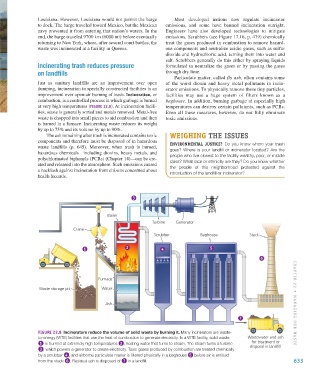Page 634 - Environment: The Science Behind the Stories
P. 634
Louisiana. However, Louisiana would not permit the barge Most developed nations now regulate incinerator
to dock. The barge traveled toward Mexico, but the Mexican emissions, and some have banned incineration outright.
navy prevented it from entering that nation’s waters. In the Engineers have also developed technologies to mitigate
end, the barge traveled 9700 km (6000 mi) before eventually emissions. Scrubbers (see Figure 17.16, p. 479) chemically
returning to New York, where, after several court battles, the treat the gases produced in combustion to remove hazard-
waste was incinerated at a facility in Queens. ous components and neutralize acidic gases, such as sulfur
dioxide and hydrochloric acid, turning them into water and
salt. Scrubbers generally do this either by spraying liquids
Incinerating trash reduces pressure formulated to neutralize the gases or by passing the gases
on landfills through dry lime.
Particulate matter, called fly ash, often contains some
Just as sanitary landfills are an improvement over open of the worst dioxin and heavy metal pollutants in incin-
dumping, incineration in specially constructed facilities is an erator emissions. To physically remove these tiny particles,
improvement over open-air burning of trash. Incineration, or facilities may use a huge system of filters known as a
combustion, is a controlled process in which garbage is burned baghouse. In addition, burning garbage at especially high
at very high temperatures (FIGURE 22.8). At incineration facili- temperatures can destroy certain pollutants, such as PCBs.
ties, waste is generally sorted and metals removed. Metal-free Even all these measures, however, do not fully eliminate
waste is chopped into small pieces to aid combustion and then toxic emissions.
is burned in a furnace. Incinerating waste reduces its weight
by up to 75% and its volume by up to 90%.
The ash remaining after trash is incinerated contains toxic WEIGHING THE ISSUES
components and therefore must be disposed of in hazardous ENVIRONMENTAL JUSTICE? Do you know where your trash
waste landfills (p. 645). Moreover, when trash is burned, goes? Where is your landfill or incinerator located? Are the
hazardous chemicals—including dioxins, heavy metals, and people who live closest to the facility wealthy, poor, or middle
polychlorinated biphenyls (PCBs) (Chapter 14)—can be cre- class? What race or ethnicity are they? Do you know whether
ated and released into the atmosphere. Such emissions caused the people of this neighborhood protested against the
a backlash against incineration from citizens concerned about introduction of the landfill or incinerator?
health hazards.
3
Boiler
Turbine Generator
Crane
Scrubber Baghouse Stack
1 2 4 5
6
Furnace
Waste storage pit Water
Ash CHAPTER 22 • MAN A GING OUR WASTE
7
FIGURE 22.8 Incinerators reduce the volume of solid waste by burning it. Many incinerators are waste-
to-energy (WTE) facilities that use the heat of combustion to generate electricity. In a WTE facility, solid waste Wastewater and ash
1 is burned at extremely high temperatures 2 , heating water that turns to steam. The steam turns a turbine for treatment or
3 , which powers a generator to create electricity. Toxic gases produced by combustion are treated chemically disposal in landfill
by a scrubber 4 , and airborne particulate matter is filtered physically in a baghouse 5 before air is emitted
from the stack 6 . Residual ash is disposed of 7 in a landfill. 633
M22_WITH7428_05_SE_C22.indd 633 13/12/14 2:25 PM

